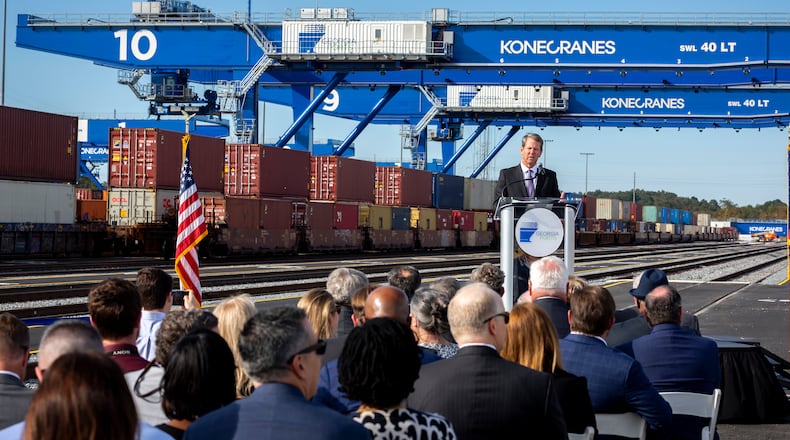After years of tough talk about China, and import tariffs begun under the Trump administration, what has happened to Georgia’s trade deficit?
It has widened.
As retailers rushed to stock inventories in advance of the holiday season, the national trade deficit reached a record high this fall. And so did Georgia’s piece of it.
Goods are pouring through the Port of Savannah at record volumes. But the overwhelming number of containers passing through are still imports — mainly from Asia, and most of those from China. Exports from Georgia have grown much more slowly.
In the past six months, 2.1 million loaded containers passed through Georgia’s main seaport. Imports represented 67% of that cargo. In October, they were 70% of the total, according to the Georgia Ports Authority.
The growing imbalance between incoming and outgoing — and the overall surge in trade — has further strained the infrastructure that moves goods from one country to another, adding to the global supply chain problems triggered by COVID-19.
In Savannah’s harbor, where at times more than 30 ships were anchored in recent months, the bottleneck is mainly the towering stacks of imports unloaded at the port and waiting to be transported to warehouses, retailers and consumers.
For months, millions of people worked or schooled from home, avoiding gyms, theater, travel, restaurants and bars. But with white-collar jobs largely intact and many laid off blue-collar workers receiving government checks, there was a massive surge of spending on things.
Even as the economy reopened, spending remained skewed away from services. And the goods that were bought — whether treadmills for consumers or machine parts for Georgia factories — were predominantly made overseas.
Since 2017, imports to Georgia rose by 8.4% — twice as much as the increase in exports. So the $54 billion deficit of 2017 grew to $60 billion by 2020.
China’s place as Georgia’s top importer — a position it has held for decades — has only grown more solid. Last year it accounted for more than one-fifth of all the imports coming into Georgia, according to the international trade division of the state’s Department of Economic Development.
Of the $98.9 billion in goods Georgia imported last year, $20.2 billion came from China, more than double the next-largest supplier of goods, Mexico.
In contrast, Georgia exports totaled $38.8 billion, $3.4 billion of that bound for China.
That imbalance parallels the longstanding national trade deficit that was one of the high-profile issues that helped propel Trump to the presidency in 2016.
During his administration, the U.S. imposed an array of tariffs on an estimated $410 billion in goods — and China responded in kind.
President Joe Biden, who earlier had criticized the trade war with China, kept the tariffs in place after he was elected. He has added some sanctions in response to China’s crackdown on Hong Kong and its apparent violations of human rights.
The result has been only a slight chill in trade, with the worst damage among American farmers. Midwestern grain, sorghum and soybean exports were the worst affected. Georgia exports of chicken and cotton continued to rise, although shipments of kaolin declined.
But in general, the trade went on and the tariffs were paid by the buyers of goods on both sides of the Pacific. Some companies absorbed the tariffs, others raised their prices and consumers paid extra.
During the first two years of the Trump administration, China imports into Georgia rose, then dipped in 2019, before rising again last year, according to the U.S. Census Bureau.
A common rationale for tariffs is the need to protect American producers from cut-rate competition and spur more domestic manufacturing. Georgia exports did rise modestly for two years, before dipping in 2020.
Even if exports are not keeping pace with imports, they are a significant part of the state’s economy, supporting many of Georgia’s 392,000 manufacturing jobs and about the same number in agriculture. And the Port of Savannah remains a crucial conduit for companies and consumers alike.
“We expect these things will be on our doorsteps when we want them, or on the shelves at the store when we want them,” said economist Tom Smith of Emory’s Goizueta Business School.
As the holiday season approached, and bottlenecks at the Port of Savannah worsened, officials opened up new rail lines and won $8 million in federal infrastructure funds to revamp a number of inland facilities for “pop-up container storage.”
Even more trade — in both directions — is nearly inevitable, Smith said.
The Biden administration hasn’t reversed Trump tariffs yet. But when it does, trade will likely increase and costs will go down, he said.
Georgia trade deficit*
2017: $50.0 billion
2020: $60.2 billion
*Amount by which imports exceed exports
____________________
Top importing countries to Georgia, 2020 (billions of dollars)
1. China $20.2
2. Mexico $9.1
3. Germany $7.4
4. South Korea $ 7.2
5. Japan $5.9
6. Singapore $4.4
7. Canada $4.3
8. United Kingdom $3.5
9. Vietnam $3.3
10. Thailand $2.9
_________________
Number of 20-foot containers handled by The Port of Savannah
October, 2021: 504,350
October, 2020: 464,100
Previous record: 498,000 (March, 2021)
__________________
Georgia Trade, 2020
Total exports: $38.8 billion
Total imports: $98.9 billion
Number of loaded containers handled by the Port of Savannah
October: 374,623
Past 12 months: 3,246,712
Sources: Census Bureau, International Trade division of the Georgia Department of Economic Development, Georgia Ports Authority
About the Author
Keep Reading
The Latest
Featured



